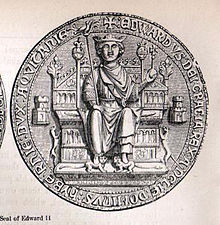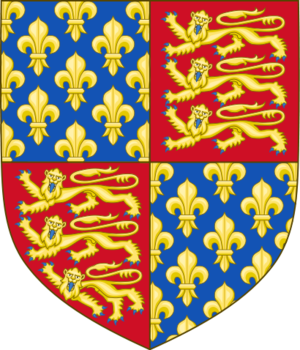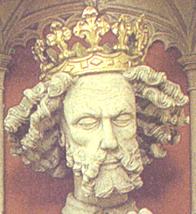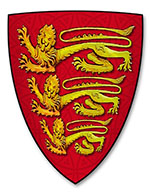| Edward II (Plantagenet) of England is managed by the England Project. Join: England Project Discuss: england |
Contents |
Biography
Edward II (25 Apr 1284 – 21 Sep 1327),[1] was deposed by wife Isabella in January 1327. Between the reigns of Edward I and III, some consider his disastrous for incompetence, squabbling and military defeats.
Edward fathered at least five children by two women, but was a rumored bisexual. His grandiose favors to unpopular male favorites (first Piers Gaveston, and later Hugh Despenser) led to constant political unrest, and his deposition.
Edward I pacified Gwynedd and some other parts of Wales and the Scottish lowlands, but never exerted a comprehensive conquest. However, the army of Edward II was defeated at Bannockburn, allowing Scottish forces to raid north England.
Edward II was probably murdered at Berkeley Castle. He's also the first monarch to establish colleges at Oxford and Cambridge: Oriel College at Oxford and King's Hall, a predecessor of Trinity College, at Cambridge.
Prince of Wales
The fourth son and eleventh child of Edward I by his first wife Eleanor of Castile, Edward II was born at Caernarfon Castle. He was the first English prince to hold the title Prince of Wales, which was formalized by the Parliament of Lincoln of 7 February 1301.
The story that his father presented Edward II as a newborn to the Welsh as their future native prince did not appear until the 16th century. The Welsh purportedly asked the king to give them a prince who spoke Welsh, and, the story goes, he answered he would give them a prince who spoke no English at all. This was no great concession as the Plantagenets spoke Norman French rather than English.
Edward became heir apparent following the death Alphonso. While trained in warfare and statecraft in childhood, Edward preferred boating and craftwork -- activities considered beneath kings at the time.
The prince took part in several Scots campaigns but, "his father's efforts could not prevent his ... extravagance and frivolity". The king attributed this to Edward's attachment to Piers Gaveston, a Gascon knight he chose in 1298 to befriend his son due to his wit, courtesy and abilities. Prince Edward attempted to give Gaveston a title reserved for royalty, so Edward I exiled the knight from court.
Edward I knighted his son in a major ceremony in 1306 called the Feast of the Swans whereby all present swore to continue the war in Scotland.
King of England
Edward I died 7 July 1307 en route to a campaign against the Scots. His son was as physically impressive, but lacked his drive and ambition. It was written that Edward II was "the first king after the Conquest who was not a man of business". His main interest was in entertainment, though he also took pleasure in athletics and mechanical crafts. He had been so dominated by his father that he had little confidence in himself, and was often in the hands of a court favorite with a stronger will than his own.
On 25 January 1308, Edward married Isabella of France,[2] to bolster a French alliance. On 25 February, they were crowned in Westminster Abbey, but the marriage was doomed from the start. Isabella neglected by her husband, who spent time conspiring with favorites to limit powers of the Peers to consolidate his father's legacy for himself.
Death and burial of Edward II
Isabella and Mortimer dared not leave the deposed king with political enemies. On 3 April, Edward II was removed from Kenilworth and put in the custody of Mortimer's subordinates, then imprisoned at Berkeley Castle.
On 23 September 1327 Edward III was told his father died 21 September 1327. Most sources agree that Edward died on that date at Berkeley Castle, but one chronicle states he died at Corfe Castle.[citation needed] Causes of death vary, but a number of chroniclers give none. Some state he was suffocated, or strangled, and a few say he was suffocated, and then killed by insertion of red hot poker into his anus.
- Nocte 10 Kalend. Octobris in lecto cubantem subitò præoccupatum cum pulvina- ribus magnis atque gravitate amplius quindecim robustorum ipsum oppressum et suffo- catum cum ferro plumbarii intensè ignito trans tubam ductilem ad egestionis partes secretas applicatum... Vita Edw . II . inter Camdeni Scriptores , pp . 601-603. [3]
This last explanation may be a later addition to lower Edward's reputation. [4]
(Royal Tombs of Medieval England) Edward died at Berkeley on 21 September (1327), most likely murdered on the orders of Roger Mortimer following an abortive attempt to spring him from the castle the previous month. On 21 October Hugh de Glanvill delivered the king's body to Gloucester Abbey, for which he was later paid 5 (pounds). It was not until 20 December that Edward was finally interred, to the north of the Gloucester high altar in the second bay. There are no records for the monument, which is the only English regal monument with an architectural canopy. According to Henry Knighton, Edward was buried away from Westminster because of his errors. Gloucester had no tradition of royal burial.
Thomas de la Moore wrote an account of Edward's murder in 1352 that is uncorroborated by other contemporary sources. Not until the relevant sections of the longer Brut chronicle were composed by an anti-Mortimer Lancastrian polemicist in the mid-1430s was the story widely circulated. The historian Michael Prestwich states that most of the poker story "belongs to the world of romance rather than of history".
Nor was there any indication at the time of Edward's death that his wife had any role in his death. It was not until late 1330, when Mortimer was tried and executed, that any writers or chroniclers start mentioning that the ex-king had been murdered.
Historian Ian Mortimer argued that Edward II was not killed at Berkeley but still alive at least until 1330. In his biography of Edward III he explores evidence including the Fieschi Letter, concluding Edward II may have died in Italy around 1341.
In her biography of Isabella, Alison Weir also considers the Fieschi Letter narrative – that Edward escaped imprisonment and lived the rest of his life in exile. Other historians, including David Carpenter, criticized Mortimer's methodology and disagree with his conclusions.
A public funeral attended by Isabella was held in 1327, after which Edward's body was said to be laid in Gloucester Cathedral. His son set up an elaborate tomb, which attracted pilgrims from far and wide.
(Royal Tombs of Medieval England) Despite the provision of a tomb effigy to confirm Edward's demise, it was rumored soon after his funeral that the king was still alive. In 1330 Edmund of Woodstock, Earl of Kent, was executed for allegedly plotting his half-brother's restoration. The same year Pope John XXII wrote to Edward III and his mother Isabelle de Valois refuting claims that he believed Edward to be alive. A letter written to Edward III by the papal notary, Manuel Fieschi, before 1345 claimed to record Edward's 'confession', according to which the king had escaped from Berkeley to Corfe, and thence to France, his body replaced by that of a porter, before traveling to Cecinia in Italy where he lived as a hermit. Thomas Berkeley was cleared of involvement in Edward's murder, claiming he was absent through illness at the time of his death.
(Royal Tombs of Medieval England) It is the French influence which probably explains the last recorded example of a medieval English king with a separate heart burial, Edward II, whose heart, enclosed in a silver casket, was placed in the coffin of his wife, Isabelle of France (d.1358), almost thirty years after his death. Isabelle herself secured papal permission for her remains to be buried in three separate locations.
(Royal Tombs of Medieval England) The deeply recessed tomb-chest suggests that Edward II's coffin does not lie within. On 2 October 1855 the pavement to the south of the tomb was raised, revealing a wooden coffin lying just below the pavement immediately beneath the tomb. The coffin was in pristine condition, and contained an inner coffin consisting of a single sheet of very thick lead, with the sides arched over the body, and a flat bottom. The inner coffin was left undisturbed.
The rule of Isabella and Mortimer did not last long after the announcement of Edward's death. They made peace with the Scots in the Treaty of Northampton, but this move was highly unpopular. Consequently, when Edward III came of age in 1330, he executed Roger Mortimer on fourteen charges of treason, most significantly the murder of Edward II (removing public doubt about his father's survival). Edward III spared his mother and gave her a generous allowance, but ensured her retirement for several years from public life. She died at Hertford on 23 August 1358.
According to the Calendar of Fines Edward III (1327–1330) held at Winchester records office, Edward III made every effort to track down his father's killers, William Ockley[5], Sir Thomas Gurney, and Sir John Maltravers[6], but they fled the country. Ockley, Gurney and Maltravers were Roger Mortimer's henchmen from the Welsh Marches.[7]
Sources
- ↑ aka Edward of Caernarfon
- ↑ daughter of King Philip IV of France
- ↑ Fosbroke, Thomas Dudley., Smyth, John., (1821)., Berkeley Manuscripts: Abstracts and Extracts of Smyth's Lives of the Berkeleys, Illustrative of Ancient Manners and the Constitution; Including All the Pedigrees in that Ancient Manuscript. To which are Annexed a Copious History of the Castle and Parish of Berkeley, Consisting of Matter Never Before Published; and Biographical Anecdotes of Dr. Jenner...: Pub: Berkeley: J. Nichols and son. Retrieved from the Internet Archive (Here;) Accessed 28 May 2023.
- ↑ Pearson, Meg F. “‘Die with Fame’: Forgiving Infamy in Marlowe’s Edward II.” The Journal of the Midwest Modern Language Association 42, no. 2 (2009): 97–120. Retrieved from Jstor (here;) Accessed 28 May 2023.
- ↑ (not Ogle)
- ↑ Jones, Joseph, Brief outlines of English history. retrieved 2014-05-05, amb
- ↑ William Ogle died before the event; he was a bailiff of Newcastle according to family history (Ogle and Bothal, British library).
- Royal Ancestry by Douglas Richardson Vol. I page 73
- Descendant (of) King William the Conqueror
- "Royal Ancestry" 2013 Douglas Richardson Vol. I. page 197
- Edward II, King of England, married Isabel Of France
- "Royal Ancestry" 2013 Douglas Richardson Vol. I. page 479
- Royal Ancestry by Douglas Richardson Vol. III page 36
- Royal Tombs of Medieval England M. Duffy 2003 p. 23, 118-123
- The Greatest Traitor - The life of Sir Roger Mortimer Ruler of England 1327-1330 Ian Mortimer 2005
- Godfrey Memorial Library. American Genealogical-Biographical Index. Middletown, CT, USA: Godfrey Memorial Library.
- American Heritage(r) Dictionary of the English Language, The. Houghton Mifflin Company. 3rd ed. 1992.
- The People's Chronology. Henry Holt and Company, Inc., Licensed by James Trager. 1994
- Royal Database. Camelot International.
- The Quarterly Journal of the Berks Archaeological and Architectural Society (Charles Slaughter, Reading, October, 1894) Vol. 3,No. 7, Page 203-4: "Letters of the First (English) Prince of Wales to Berkshire Ecclesiastics"
See also:
- Wikipedia: Edward II of England
- Wikidata: Item Q5236

- Time Team Season 16, Episode 2 The Wedding Present (Scargill Castle, Co Durham)
It may be possible to confirm family relationships with Edward II by comparing test results with other carriers of his Y-chromosome or his mother's mitochondrial DNA. Y-chromosome DNA test-takers in his direct paternal line on WikiTree:
- Richard III (York) of England
 :
Y-Chromosome Test 22 markers, haplogroup G-P287, MitoYDNA ID Z10009 [compare]
:
Y-Chromosome Test 22 markers, haplogroup G-P287, MitoYDNA ID Z10009 [compare]
Have you taken a DNA test? If so, login to add it. If not, see our friends at Ancestry DNA.
 C. Mackinnon
C. Mackinnon
Featured National Park champion connections: Edward II is 18 degrees from Theodore Roosevelt, 22 degrees from Stephanus Johannes Paulus Kruger, 18 degrees from George Catlin, 20 degrees from Marjory Douglas, 27 degrees from Sueko Embrey, 19 degrees from George Grinnell, 22 degrees from Anton Kröller, 18 degrees from Stephen Mather, 24 degrees from Kara McKean, 21 degrees from John Muir, 16 degrees from Victoria Hanover and 29 degrees from Charles Young on our single family tree. Login to find your connection.
P > Plantagenet | O > of England > Edward (Plantagenet) of England
Categories: England, Notables | Feudal Barony of Pevensey | Nominated Profiles | England, Monarchs | Princes of Wales | Battle of Bannockburn | Battle of Boroughbridge | This Day In History April 25 | This Day In History September 21 | 13th Century | 14th Century | Time Team | Famous Feuds | House of Plantagenet | Notables






